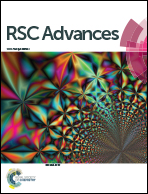A green approach to prepare hierarchical porous carbon nanofibers from coal for high-performance supercapacitors†
Abstract
A green method is designed to obtain hierarchical porous carbon nanofibers from coal. In the work, deionized water, coal, polyvinyl alcohol and Pluronic F127 are used as the aqueous solution, carbon source, spinning assistant and soft template for spinning, respectively. As electrode materials for supercapacitors, the obtained hierarchical porous carbon nanofibers exhibit a high specific capacitance of 265.2 F g−1 at 1.0 A g−1 in 6 M KOH, a good rate performance with a capacitance of 220.3 F g−1 at 20.0 A g−1 with the retention of 83.1% and a superior cycle stability without capacitance loss after 20 000 charge/discharge cycles at 10.0 A g−1. Compared with the carbon nanofibers constructed without Pluronic F127, the enhanced electrochemical performance of the sample benefits from a larger contact surface area and the mesoporous structure formed by decomposition of Pluronic F127 and good structural stability. This work not only provides a green route for high-value utilization of coal in energy storage, but also paves a new way to make hierarchical porous carbon nanofibers from coal for supercapacitor electrodes with high specific capacitance and long cycle life.



 Please wait while we load your content...
Please wait while we load your content...